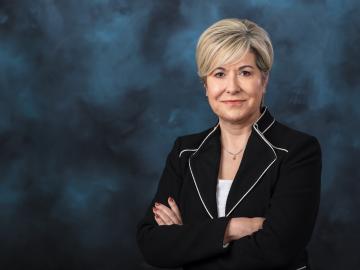
Filter News
Area of Research
- Advanced Manufacturing (2)
- Biology and Environment (15)
- Computational Engineering (1)
- Computer Science (5)
- Energy Science (21)
- Fusion and Fission (4)
- Isotope Development and Production (1)
- Isotopes (2)
- Materials (27)
- Materials for Computing (4)
- National Security (10)
- Neutron Science (7)
- Nuclear Science and Technology (4)
- Sensors and Controls (1)
- Supercomputing (21)
News Type
News Topics
- (-) Artificial Intelligence (51)
- (-) Biotechnology (14)
- (-) Microscopy (28)
- (-) Partnerships (33)
- (-) Security (13)
- (-) Space Exploration (13)
- 3-D Printing/Advanced Manufacturing (82)
- Advanced Reactors (25)
- Big Data (25)
- Bioenergy (42)
- Biology (47)
- Biomedical (28)
- Buildings (36)
- Chemical Sciences (48)
- Clean Water (16)
- Composites (23)
- Computer Science (105)
- Coronavirus (28)
- Critical Materials (23)
- Cybersecurity (20)
- Education (3)
- Element Discovery (1)
- Emergency (1)
- Energy Storage (75)
- Environment (86)
- Exascale Computing (14)
- Fossil Energy (2)
- Frontier (17)
- Fusion (26)
- Grid (38)
- High-Performance Computing (44)
- Hydropower (6)
- Irradiation (2)
- Isotopes (25)
- ITER (5)
- Machine Learning (27)
- Materials (96)
- Materials Science (90)
- Mathematics (3)
- Mercury (5)
- Microelectronics (1)
- Molten Salt (8)
- Nanotechnology (41)
- National Security (21)
- Neutron Science (81)
- Nuclear Energy (47)
- Physics (30)
- Polymers (23)
- Quantum Computing (18)
- Quantum Science (43)
- Simulation (19)
- Statistics (2)
- Summit (30)
- Transportation (62)
Media Contacts

Ateios Systems licensed an ORNL technology for solvent-free battery component production using electron curing. Through Innovation Crossroads, Ateios continues to work with ORNL to enable readiness for production-quality battery components.

Effective Dec. 4, Gina Tourassi will assume responsibilities as associate laboratory director for the Computing and Computational Sciences Directorate at the Department of Energy’s Oak Ridge National Laboratory.

Four scientists affiliated with ORNL were named Battelle Distinguished Inventors during the lab’s annual Innovation Awards on Dec. 1 in recognition of being granted 14 or more United States patents.

ORNL is home to the world's fastest exascale supercomputer, Frontier, which was built in part to facilitate energy-efficient and scalable AI-based algorithms and simulations.

ORNL has joined a global consortium of scientists from federal laboratories, research institutes, academia and industry to address the challenges of building large-scale artificial intelligence systems and advancing trustworthy and reliable AI for

Scientists at ORNL used their expertise in quantum biology, artificial intelligence and bioengineering to improve how CRISPR Cas9 genome editing tools work on organisms like microbes that can be modified to produce renewable fuels and chemicals.

The application to participate in the third cohort of the Techstars Industries of the Future Accelerator in Knoxville, Tennessee, is open through Nov. 29, 2023.

The Department of Energy’s Oak Ridge National Laboratory and Tennessee State University have signed a memorandum of understanding to strengthen research cooperation and provide diverse undergraduate students enriching educational research opportunities at the lab.

ORNL and the University of Texas Rio Grande Valley, known as UTRGV, have signed a memorandum of understanding to strengthen research cooperation and establish a collaborative program for undergraduate research and education, further cementing hi

Susan Hubbard, diputada de Ciencia y Tecnología en ORNL, Can (John) Saygin, vicepresidente mayor de investigación y decano del Colegio de la Escuela de Postgrados en UTGRV, firman un Memorándum de Entendimiento comprometiéndose a fortalecer


